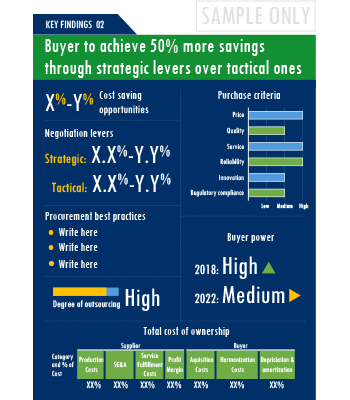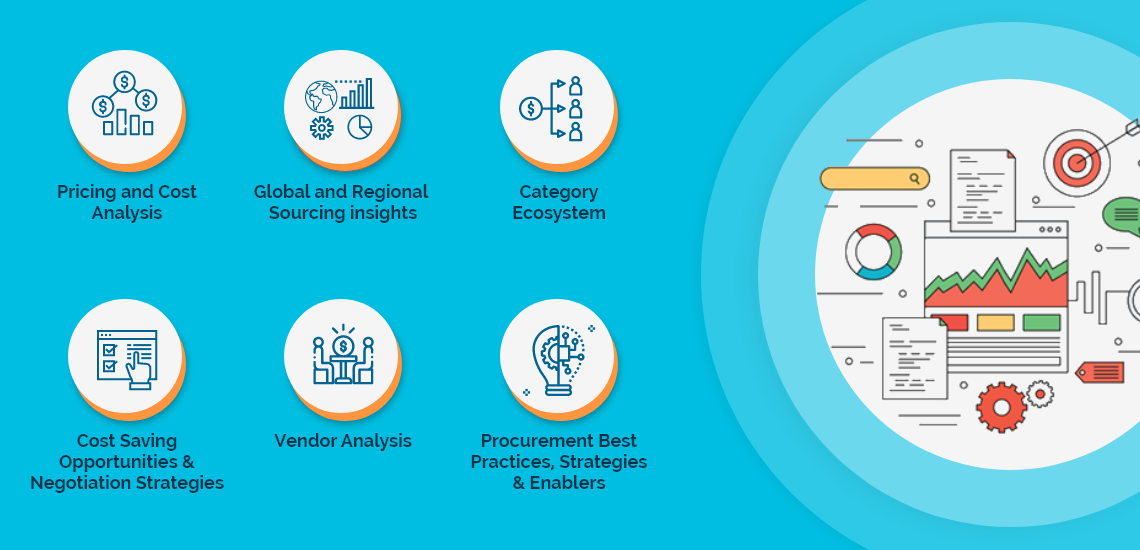A purchasing guide for Mercury – rich advisory on spend outlook in Mercury, pricing analysis for Mercury procurement cost benchmarking, negotiation strategies and key vendors of Mercury.
GET FREE SAMPLEMercury is an essential part of the Non-Medical Chemicals Minerals and Gases category which includes all spend on procurement, transportation, conservation and storage of industrial chemicals, minerals and gases. Spend on similar products for medical and pharmaceutical usage is excluded from this category.
The market for Non-Medical Chemicals Minerals and Gases and its sub-segments such as Mercury are at an interesting intersection. Customers are expecting service and experience levels which are at par with what ecommerce and consumer sectors of today offer. Moreover, competition keeps intensifying and demand and supply dynamics keep shifting.Procurement costs for Mercury are highly impacted by an increase in the costs associated with the value chain of Mercury, such as logistics, labor cost and energy. Additionally, outdated assets are also increasing the cost for suppliers.Suppliers of Mercury are moving up the value chain - both organically as well as through M&As. Their portfolios are increasingly being diversified with the objective of offering integrated solutions that go beyond just Mercury. Even buyers are engaging vendors who can act as a one-stop solution provider across their geographic footprint. Such strategic engagements can help buyers with savings associated with economies of scale and management of a much smaller supplier base.Trends like these and many others discussed in this report are necessitating a relook at the way Mercury is procured and the procurement cost saving opportunities that exist.
The report discusses in detail the best practices that have served well the category managers responsible for Mercury procurement. For example, Buyers must have a clear understanding of the subcontracting policies, if any, of Mercury suppliers. Factors such as cost incurred, service quality, adherence to timelines, and regulatory compliance of subcontractors employed by suppliers should be carefully assessed prior to engagement. Buyers need to evaluate the in-depth expertise of suppliers in the Mercury industry. This can be assessed by considering factors such as the years of experience, number of resources that have multi-year experience of working in the same industry and at least 3 to 5 credentials for the supplier. Buyers should engage with suppliers that have adopted a global delivery model as it reduces buyers' risk. In this model, any disaster/emergency at any operating facility of supplier will result in the work being transferred to a different facility, thereby ensuring continuity of the project and reduced risk for buyers. This model also provides buyers access to skilled labor from across the globe, thereby improving the quality of engineering products provided by the supplier.
Activate your free account to gain easy access to cutting edge research and insights on consumers, emerging price trends, global and regional suppliers.
Mercury procurement managers also need to proactively identify and mitigate potential risks that can arise in the supply chain or contracts for Mercury procurement. Some examples include:
For detailed insights and complete access to our report library, activate your free account!
The report is intended to serve as a one-stop reference guide for Mercury procurement strategy and offers a perfect blend of category basics with deep-dive category data and insights. Therefore, it is ideal for category beginners looking for “Mercury: Procurement Report 101” as well as for category experts actively tracking the global Mercury procurement market.
You may have just initiated your research to design a winning Mercury procurement strategy, or you may be a category expert looking for strategic insights and updated data.Either ways, the report has your requirements covered.

Unlock SpendEdge's comprehensive procurement report collection with ease through our procurement platform.
Procurement decisions can prove to be costly in the absence of careful deliberation and evaluation of every available option. In fact, more than 90% of the decision makers we work with acknowledge that timely availability of up-to-date category intelligence can help them make better purchasing decisions. More than 80% of them believe that in-house category intelligence needs to be updated periodically to achieve full benefits. If you have read so far, we are quite sure you agree!!
The Mercury procurement report helps take more informed decisions by placing all the critical information and advice at the fingertips of a decision maker. It also specifically answers some of the key questions that we have been routinely asked during our industry outreach initiatives:
SpendEdge Insights has helped procurement professionals and sourcing teams manage multiple spend areas and achieve more than $2 billion in savings. Activate your free account today!
The Mercury market report offers a complete picture of the supply market and analyzes the category from the perspective of both buyers and suppliers. Analysis of the category trends, procurement best practices, negotiation levers and overall category management strategy advisory are interspersed with in-depth data and commentary on spend outlook, pricing ecosystem and supplier landscape drilled down to a region-level coverage.

A key highlight of this report is the in-depth outlook created on Mercury procurement spend and pricing trends. The report further delves deep into the aspects of cost structure, total cost of ownership and supplier margins for Mercury. A dedicated section to supplier profiles and evaluation helps decision makers cast a wider procurement net and identify gaps in existing relationships.

Along with specific category and supplier intelligence, the publication also includes curated insights on Mercury market trends, price influencers and inherent risks. These insights help the decision makers prepare for market shaping trends in advance and create alternative strategies for changes in the market conditions.

Additionally, the report also advises on the best practices and strategies to manage the Mercury category efficiently. Negotiation levers and opportunities are explained in detail along with quantification of their potential. Benchmark KPIs for supplier and buyer performance management are also aggregated to better organize the category objectives. Other themes of advisory include ideal procurement organization structure, enablers to achieve KPIs or category objectives and ideal SLAs to have with suppliers.






Our research is complex, but our reports are easy to digest. Quantitative analysis and exhaustive commentary is placed in an easy to read format that gives you an in-depth knowledge on the category without spending hours to figure out “what does it mean for my company?”


SpendEdge presents a detailed picture of Mercury procurement solutions by way of study, synthesis, and summation of data from multiple sources. The analysts have presented the various facets of the market with a particular focus on identifying the key category influencers. The data thus presented is comprehensive, reliable, and the result of extensive research, both primary and secondary.

Global Saturated Acyclic Hydrocarbons Market - Procurement Intelligence Report

Global Sulphides, Sulphites And Sulphates Market - Procurement Intelligence Report

Global Synthetic Semi-Precious Stones Market - Procurement Intelligence Report

Global Neon Market - Procurement Intelligence Report

Global Inorganic Pigments Market - Procurement Intelligence Report

Global Magnesium Oxide Market - Procurement Intelligence Report

Global Sodium Carbonate Market - Procurement Intelligence Report

Global Oxometallic Acid Salts Market - Procurement Intelligence Report

Global Downhole Chemicals Market - Procurement Intelligence Report
Access this report and our entire procurement platform | Plans starting from USD 3000/ Year Buy Now
Copyright © 2026 Infiniti Research Limited. All Rights Reserved. Privacy Notice – Terms of Use – Sales and Subscription
Cookie Policy
The Site uses cookies to record users' preferences in relation to the functionality of accessibility. We, our Affiliates, and our Vendors may store and access cookies on a device, and process personal data including unique identifiers sent by a device, to personalise content, tailor, and report on advertising and to analyse our traffic. By clicking “I’m fine with this”, you are allowing the use of these cookies. You may change your settings based on a legitimate interest at any time, by selecting “Manage Settings” on our site. Please refer to the help guide of your browser for further information on cookies, including how to disable them. Review our Privacy & Cookie Notice.
